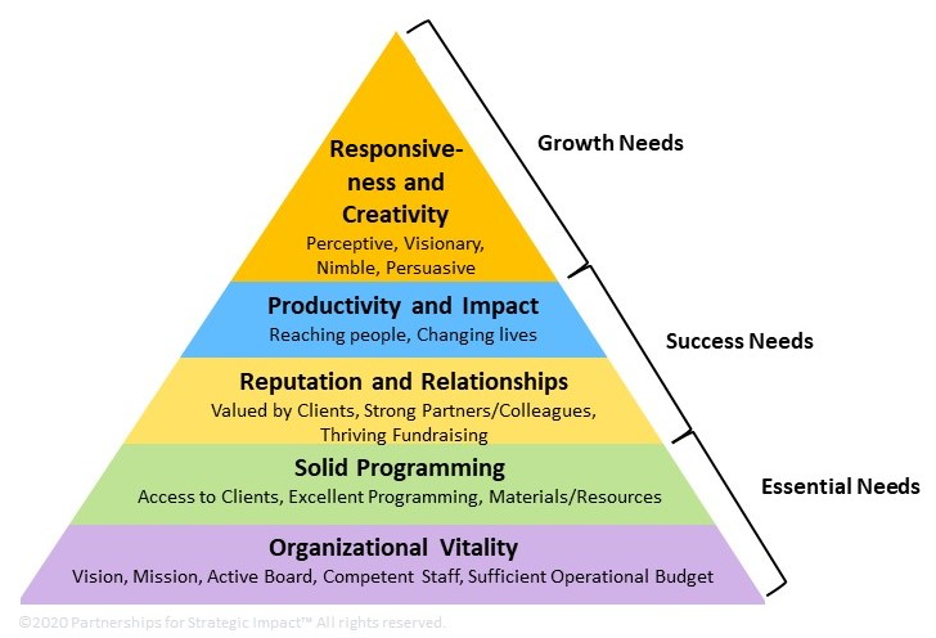I’m Maryfrances Porter, the President and Founder of Partnerships for Strategic Impact™. We specialize in helping nonprofits, governments, foundations, and corporate CSRs design maximally effective programs and initiatives, ensure high quality implementation, demonstrate impact, and to get their data working for them. In our work since COVID19, we have identified 6 strategies to help structure program pivots and changes in data collection!
Strategy #1: Focus on basic needs – of your clients and your organization. When in crisis, go back to the basics. Make sure you shore up your organization’s basic needs, while you distill your mission to focus on the most basic needs of your clients that still fall within the core of what you do. Rad Resource: Check out the Hierarchy of Nonprofit Needs we created!
Strategy #2: Focus on recording reach and telling the story. It’s likely that access to your clients has changed and just reconnecting is very important work. Having clients complete surveys might not just be impossible, it is probably hard to figure out what knowledge, skills, or abilities you are giving people other than helping them access resources. However, it’s a wonderful time to capture the stories of how people struggle and overcome the challenges of COVID19 are going to be critical in the future. Rad Resource: Consider the StoryCorps model for capturing stories.
Strategy #3: Allow data collection to be flexible. Because this time is so dynamic, the data you need today might not be the data you need tomorrow. That’s ok! Focus on what’s important right now and change what you collect when needed. Simple tools like GoogleSheets or GoogleDocs can be helpful in creating quick, flexible, and accessible templates for entering data.
Strategy #4: Talk to your funders and stakeholders. No one will be surprised that your organization is pivoting what you do or how you collect data – but funders don’t want to be in the dark. Talk with them early and often about organizational changes.
Strategy #5: Enter all pre-COVID19 data. Your staff will forget what they did, and later you’ll thank yourself 1000 times over for stopping and catching up on pre-COVID19 data entry. Stop. Right now. Get it entered.
Strategy #6: Channel your inner visionary to scenario planning and creativity. You probably got where you are today, in part, because you’re a visionary. With the future so uncertain, redeploy that energy into planning for various near future scenarios (and create a deadline where you have to pick a scenario regardless of what information is available) and into creativity. There are a lot of amazing innovations and opportunities that will come out of this time.

Do you have questions, concerns, kudos, or content to extend this aea365 contribution? Please add them in the comments section for this post on the aea365 webpage so that we may enrich our community of practice. Would you like to submit an aea365 Tip? Please send a note of interest to aea365@eval.org. aea365 is sponsored by the American Evaluation Association and provides a Tip-a-Day by and for evaluators.

Hello Maryfrances,
Thank you for this post. It is amazing that even one year later, these strategies are still so relevant to our current situation. I really resonated with Strategy #2. The idea of capturing stories is something that I have tried before but always in an informal way. Throughout this pandemic, traditional methods of data collection may no longer be possible or effective. We can gain so much insight through the stories of our clients (or in my case students) and letting them tell it in a way that is authentic to them and not guided by standardized questions. This in turn builds on the story we are trying to tell about the impact of what we do.
Strategy #3 is also one that can be applied in the ever-changing program landscape. Sometimes I get stuck in comparing data or making sure I can show year-over-year comparisons. This usually means that I am very rigid in the types of data I collect. Being more flexible and adaptable is a lesson I am still learning. As our services and evaluations change, so too should our data collection.
Thank you for sharing these strategies and resources.
Mandie Zhang
Thank you for the fantastic post Maryfrances!! I really like how you mentioned the urgency to get the pre-COVID data entered. Because I work primarily with STEM education programs the summer months are my heavy report writing season. 🙂 Looking through and analyzing my pre-COVID data for education programs is encouraging to my clients. It reminds them that good work will continue regardless of the obstacles before us.
Thank you also for the wonderful pyramid graphic. What a beautiful way of describing impacts.
Cheers,
Sondra LoRe, Ph.D.
Manager | National Institute for STEM Evaluation and Research (NISER)
Adjunct Professor | Evaluation, Statistics, and Measurement Program, Department of Educational Psychology & Counseling
The University of Tennessee, Knoxville
Office of Research & Engagement
114 Philander P. Claxton Education Building
slore@utk.edu